Hostas: planting and care, varieties and species
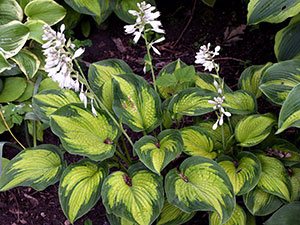 Hosta (lat. Hosta), or funkia, is a genus of herbaceous perennials in the family Asparagaceae, although it used to be included to the family Liliaceae. Hosta was named in honor of the Austrian botanist and doctor N. Host, and the second name funkia was received in honor of H. Cr. Funk, a German botanist. In total there are about 40 species of this plant. Hosta is native to East Asia (Korea, China, Japan), the southwest of the Far East, Sakhalin and the Kuril Islands. Moisture-loving hostas grow near the banks of rivers and streams, on the slopes of mountains and forest edges.
Hosta (lat. Hosta), or funkia, is a genus of herbaceous perennials in the family Asparagaceae, although it used to be included to the family Liliaceae. Hosta was named in honor of the Austrian botanist and doctor N. Host, and the second name funkia was received in honor of H. Cr. Funk, a German botanist. In total there are about 40 species of this plant. Hosta is native to East Asia (Korea, China, Japan), the southwest of the Far East, Sakhalin and the Kuril Islands. Moisture-loving hostas grow near the banks of rivers and streams, on the slopes of mountains and forest edges.
The Japanese consider the hosta flower to be a sacred plant, and the petioles of leaves are used for food as a delicacy. When hosta appeared in England, it did not impress the local residents, but, after getting in the New World, very soon it became the most popular plant. Its success was so enormous that its popularity quickly spread to other continents.
Description of hosta flowers
 The hosta plant is diverse. That's why it will fit in any garden composition. It is an ornamental rhizome plant that can grow thick very quickly and form plantations. The main ornament of hosta is its large leaves of all possible variations depending on the species and variety of hosta. Hosta is an universal, easy-to-grow, cold- and drought-resistant plant that grows well in the shade and is a worthy companion for other plants. Hosta reaches the peak of its beauty when it is five year old.
The hosta plant is diverse. That's why it will fit in any garden composition. It is an ornamental rhizome plant that can grow thick very quickly and form plantations. The main ornament of hosta is its large leaves of all possible variations depending on the species and variety of hosta. Hosta is an universal, easy-to-grow, cold- and drought-resistant plant that grows well in the shade and is a worthy companion for other plants. Hosta reaches the peak of its beauty when it is five year old.
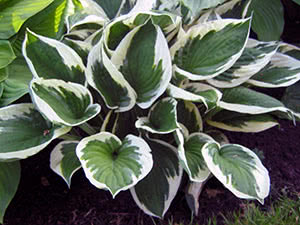 Despite the diversity of species and varieties, all hostas are stemsless, herbaceous with thickened, compact and short-branched rhizomes that have a lot of cord-like roots, allowing plants to firmly anchor to the soil. Bluish, white, pink and purple flowers of hosta can be simple or double. They are collected in a truss effectively rising over a leafy rosette on tall, almost bare peduncles. Unlike all other shade-tolerating plants the flowers of which usually are plain-looking, the flowers of hosta are magnificent: funnel-shaped or funnel-bell-shaped, collected in one-sided, racemose inflorescences. Hosta fruit is a leathery three-edged capsule with numerous seeds that retain their germination for about a year.
Despite the diversity of species and varieties, all hostas are stemsless, herbaceous with thickened, compact and short-branched rhizomes that have a lot of cord-like roots, allowing plants to firmly anchor to the soil. Bluish, white, pink and purple flowers of hosta can be simple or double. They are collected in a truss effectively rising over a leafy rosette on tall, almost bare peduncles. Unlike all other shade-tolerating plants the flowers of which usually are plain-looking, the flowers of hosta are magnificent: funnel-shaped or funnel-bell-shaped, collected in one-sided, racemose inflorescences. Hosta fruit is a leathery three-edged capsule with numerous seeds that retain their germination for about a year.
 Hosta leaves are basal, lanceolate and cordate, long-petioled, pointed, having noticeable veins and affecting with their color diversity. In fact, the leaves are their main advantage. The colors of the leaves vary depending on the species and variety of hosta: from all shades of green and blue to white and yellow. And there are also a great number of variants of color combination: strokes, stains, stripes and so on. The texture of the hosta leaves is also diverse: folded, wrinkled, waxy, with a metallic tint, simply glossy or matte ... The height of the plants is about 20-32 inches, but in cultivation there are both dwarf varieties not exceeding 6 inches in height, and giant varieties over 47 inches high.
Hosta leaves are basal, lanceolate and cordate, long-petioled, pointed, having noticeable veins and affecting with their color diversity. In fact, the leaves are their main advantage. The colors of the leaves vary depending on the species and variety of hosta: from all shades of green and blue to white and yellow. And there are also a great number of variants of color combination: strokes, stains, stripes and so on. The texture of the hosta leaves is also diverse: folded, wrinkled, waxy, with a metallic tint, simply glossy or matte ... The height of the plants is about 20-32 inches, but in cultivation there are both dwarf varieties not exceeding 6 inches in height, and giant varieties over 47 inches high.
Species and varieties of hostas
Hosta flower with all its numerous species and varieties is widely used in landscape design. Today hybrid hosta has more than 4,000 varieties. But there are not so many main species on the basis of which this diversity occurred. Species of hostas that served as the basis for breeding are as follows:
- Curled hosta (the height is 24 inches, the leaves are broad, dark green with a white border; its variety is Dream Weaver).
- Tall hosta (it is up to 35 inches tall, the leaves are large, glossy, dark green; for example, its variety is Tom Schmid).
- Gold-edged hosta (the height is up to 20 inches, green leaves are with a cream border; its variety, for example, is hosta fortunei albopicta).
- Siebold hosta (it is up to 24 inches tall, leaves are with obvious veins; its variety, for example, is Elegans).
- Wavy hosta (it is up to 29 inches high, the leaves are with a wavy edge, the center is white with green bordering strokes; the variety is Undulata Mediovariegata, for example).
- Hosta ventricosa (it is up to 20 inches, the leaves are with pointed tips, the variety is Thomas Hogg).
- Plantain lily (it is up to 20 inches, the leaves are bright green, glossy, the variety is Royal Standard).
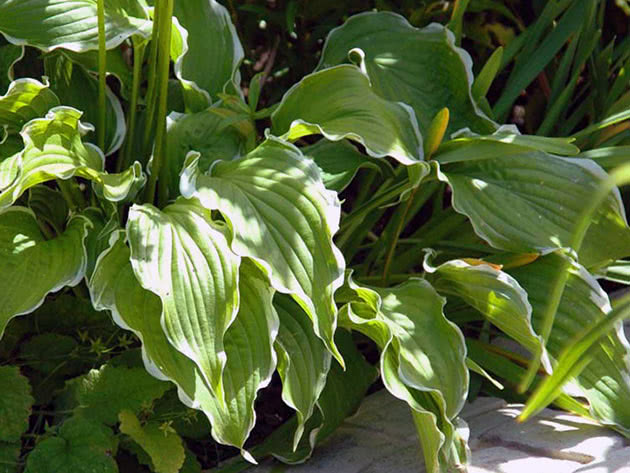
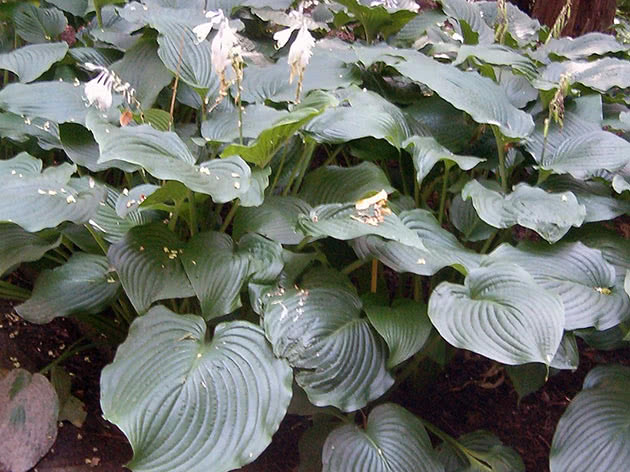
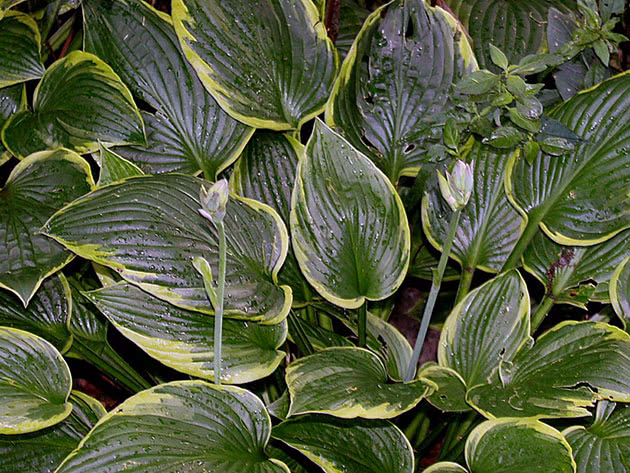
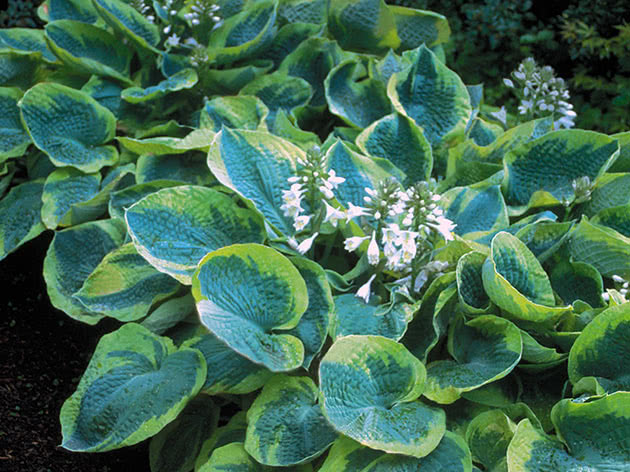
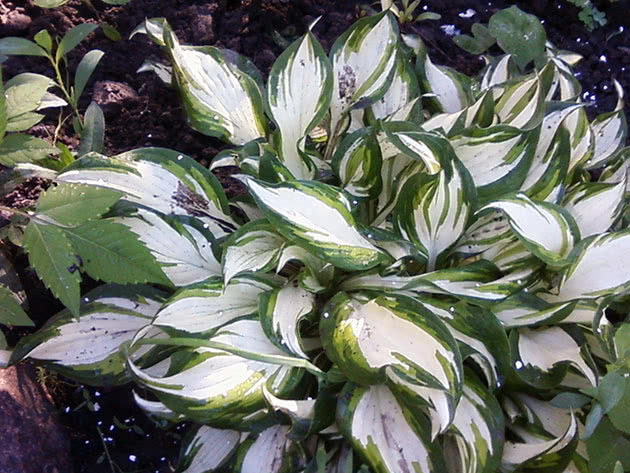
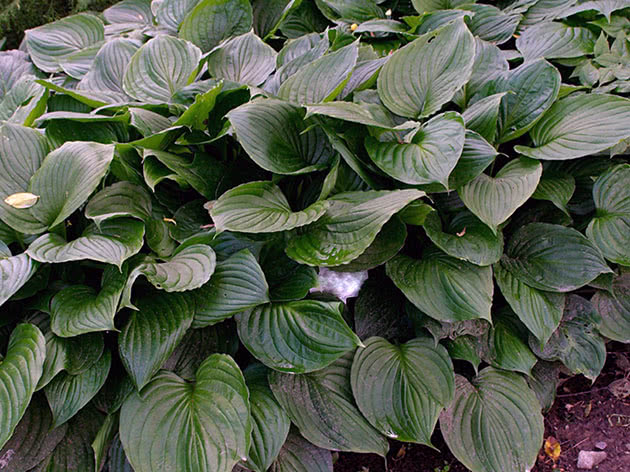
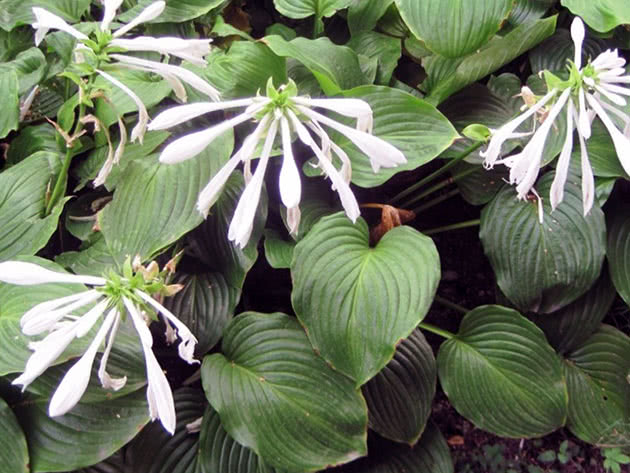
Numerous varieties of hostas are also classified by: a) color; b) size. By color of the leaves, hostas are divided into five groups:
- blue hosta (hosta blue – B) – the color of the leaves is bluish-gray;
- yellow hosta (Go) – it combines all yellow-leaved hostas;
- green hosta (Gr) – it includes all shades of green;
- hosta variegata (V) – it unites variegated varieties of hostas, as well as varieties with a light border along the edge;
- mediovariegata hosta (MV) – it combines light leaves with a green border along the edge.
By size hostas are divided into 6 groups:
- dwarf – these are the plants not more than 4 inches high, Draft (D): Blue Mouse Ears (bluish small leaves really look like mouse ears),
- miniature – the hostas are from 4 to 6 inches high, Miniature (Mini): La Donna (the leaves are bluish-yellow-green),
- small – the hostas are from 6.3 to 10 inches high, Small (S): Gold Town hosta (green leaves with a white or yellow stripe), Headsmen Blue (leaves are blue-green);
- medium – the hostas are from 11.8 to 20 inches, Medium (M, Med): Night Before Christmas (dark green leaves with white center), So Sweet (green leaves with a cream-white border), White Feather (a unique white hosta that gradually becomes green over time);
- large – it is from 22 to 27.5 inches, Large (L): Alvatine Taylor (bluish-green leaves with a greenish-yellow border), Golden Meadows (rounded shrunken leaves with a golden center, broad green border and pale green strokes);
- giant – it is over 27.5 inches high, Giant (G): Blue Vision (bluish-green leaves), Sum of All (the center of the leaf is green, on the edge there is a wide golden border).
Growing of hostas from seeds
How to grow hosta in a pot
Hostas are propagated by bush division, seeds, and from cuttings. Those who prefer breeding hostas by seeds should know that growing of hostas in this way depends on the presowing processing of the material by growth stimulators (soaking in growth-promoting hormones, or aloe juice for half an hour), since seed germination capacity is weak (70-80%). Some growers advise to apply the method of stratification (keeping the seeds in the cold for a month) to improve germination capacity. The second very important key to success is the sterility of the substrate, in which there should be no fungi and other microorganisms, otherwise the seedlings can grow sick. So it is better to buy the substrate in the plant nurseries. The substrate should include perlite, peat and vermiculite.
In April-May you should treat a pot with a surgical spirit or potassium permanganate solution, put a layer of drainage in the pot, add and water the substrate well. Then sprinkle the hosta seeds over the surface, cover them with a 0.2-0.3 inch of substrate, slightly compact it and cover the pot with glass or foil to retain the moisture. During germination the soil temperature should be 64-77ºF, and then the shoots will appear in two or three weeks. Protect the seedlings from direct sunlight, provide them with moderate watering, remove condensation on time. Seeds do not need bright light, so keep them in a light shade until their emergence, but then place them in a well-lit place.

The seedlings are pricked out in separate pots after the appearance of a couple of leaves: the shoots are transferred to the soil, a quarter covered with sand. To moisten the pricked-out seedlings, the bottom watering is applied: hosta in the pot is placed in a deep pan with water and kept there until the top layer of the soil “gets wet”. Now the seedlings need to be hardened by removing the foil or glass for several hours. In a week remove the cover completely, and place hosta outside for a while, provided that the temperature is not below 64ºF. Keep in mind that hosta seedling develop very slowly, and generally, the hosta grown from seeds often loses varietal characteristics.
Planting of hostas in the garden
When to plant hosta
Before you plant hosta you need to choose a comfortable planting site. You should remember that hosta can grow on one site without being replanted for 20 years, and with each year it will be getting prettier and prettier. The best conditions are a partial shadow with protection from drafts, but remember: the brighter the hosta leaf is and the more it has white and yellow fragments, the more sun-loving the variety is. It is desirable for variegated hostas to grow in a place shaded at noon, but with full sun in the morning and evening. Blue varieties should be planted only in the shade, two hours of sun per day will be enough for them. The thicker the shadow is, the slower hosta grows, but the larger the leaves are and the higher the bush is.
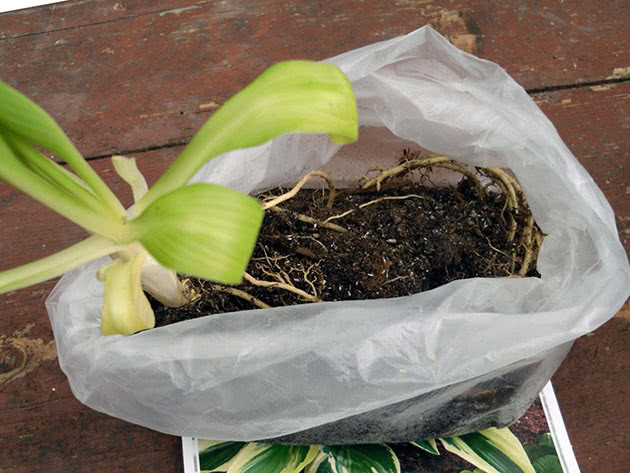
Hosta requires moist soil that is rich in humus, neutral or slightly acidic, with good drainage. Hosta does not like sand and heavy loam. It is best to prepare the soil for the spring planting in autumn: put a 4 inch layer of organic fertilizers over the planting site and dig up the soil to the depth of the bayonet shovel. By spring the soil on the site will be ready for planting. Planting of hosta in the ground is carried out after the last frost. In cold climate zone this is the end of April – the middle of May.
How to plant hosta
Planting holes for seedlings are located at a distance of 12-23 inches, depending on the plant species. For a giant hosta the distance between the bushes should be 2.6-3.3 ft. If you plant seedlings grown in the pot, water them a few hours before planting. If you plant and divide a hosta bush, then remove dried, rotten or damaged roots from the sections. Seedlings from the pot (or sections) are put in the prepared planting holes with a clod of soil 0.8-1.2 inches below the ground level, the roots of hosta are neatly straightened, covered with soil, compacted and watered abundantly. The area around the root is mulched with crushed bark.

Care for hosta
How to care for hosta in the garden
If hosta grows in a fertile soil, then there is no need to feed it for three or four years. The main top dressing for hosta is humus and compost that should be applied in autumn as mulch. It is undesirable to apply mineral fertilizers, but if you decide that they are necessary, scatter granulated fertilizer around hosta after rain or copious irrigation. Liquid fertilizers (root and foliar ones) are applied every two weeks until the middle of July, and then stop their using, otherwise hosta will continue to develop new leaves and will not have enough time to prepare for winter. The soil around the plants should be moist all the time, especially around the young hosta, so it is very important to water the plants in time, and watering should be carried out in the early morning and under the root rather than on leaves (water spoils them). In addition, the sheet of water should not be strong not to compress the soil, quite the contrary, it should saturate the soil with water as deep as possible. The signal that the plants do not have enough water is the darkening of the tips of the leaves of hostas.
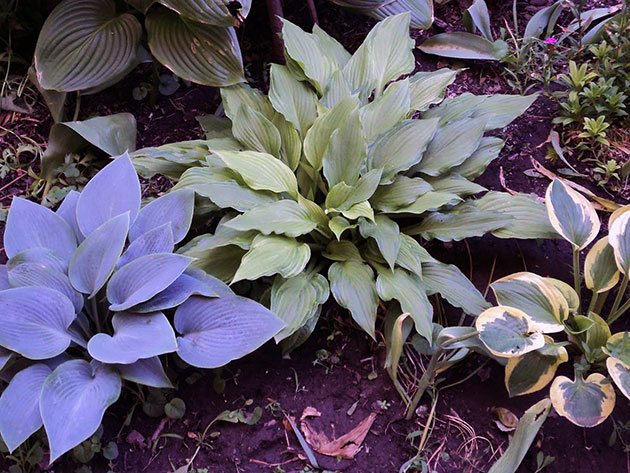
If you are interested in making the hosta bush look neat, you will have to break out the young peduncles, otherwise after blooming hosta will “fall apart”. Loosening and weeding are necessary at first; when it grows big enough, it will not be afraid of weeds. In three or four years, hosta needs to be divided, since it will grow too big. Dig out hosta and separate the young cuttings from the main root. This procedure does not hurt a healthy plant.
Diseases of hosta
Hostas are minimal care plants, but the experts say that the more varieties of hosta there are in your collection, the higher the risk of getting an infected specimen is. Sometimes weak or frost-bitten hostas get damaged by leaf blight – fungal disease manifested as yellow-brown merging spots on the leaves. Sometimes the peduncles are affected by the fungus Phyllosticta aspidistrae Oud. Infected plants are removed and burned, and the soil in this place is disinfected.

Hosts suffers from gray rot (Botrys cinerea) and from sclerotinia (Sclerotinia). Gray rot damages the leaves of hosta, it is controlled by fungicides. Sclerotinia is a fungus, white cotton mold that is fatal to the root neck of hosta. It is controlled with dichlorine.
Pests of hosta
The main pest of plants is slugs. A sign that hosta has attracted these garden pests is large holes on the leaves. It is easy to control them: place a bowl of beer around the plants, and a day later go through and collect slugs that have slipped down to drink a beer.
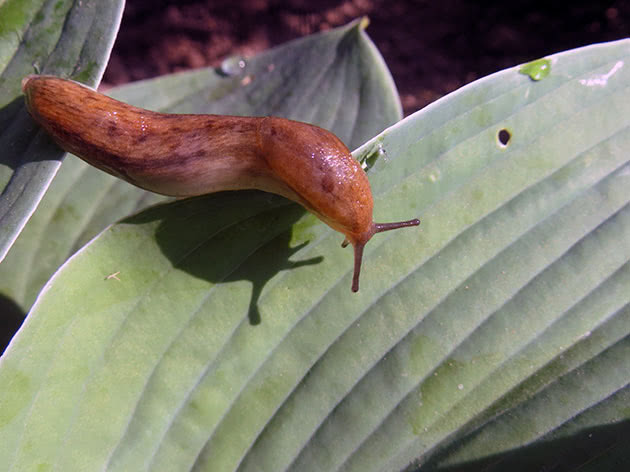
In addition to slugs stem nematodes also attack hosta. The signs of their vital activity look like the necrotic patches of yellow color flowing between the veins of the leaves. There is a simple test to detect nematodes: put a thinly sliced leaves of hosta into a thin-walled glass, fill it with water for half an hour, and then hold the glass up to the light. If there are nematodes, then you will see how worms swim in the water. It is impossible to fight with nematodes, because chemical preparations do not destroy eggs laid by them, and they will give new nematodes next year. Plants will have to be destroyed within a 6.5 ft radius from the affected specimen.
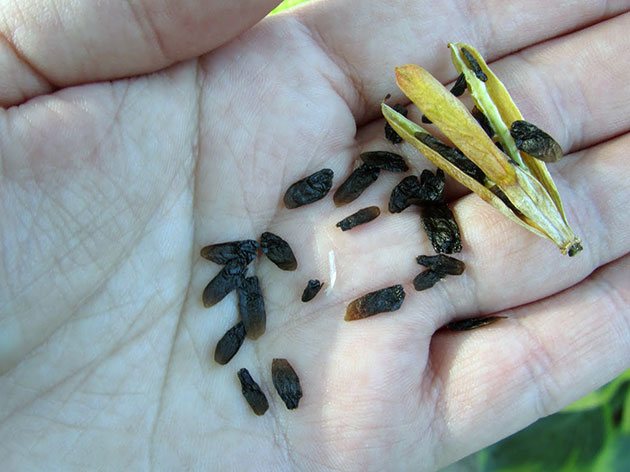
Caterpillars can be also dangerous for hostas. They can appear unexpectedly and destroy the entire plant in just one night, as well as beetles and grasshoppers, after the invasion of which the leaves look like Swiss cheese. Only insecticides can rid of hosta from insects.
Hosta after flowering
When flowering has ended, the peduncles should be removed. In September hosta starts preparing for the dormant period. At the same time, the growers plant out hosta. First, half an hour before planting you need to water the area on which you plan to work. Then the bushes are dug out and divided so that each section has one or more leaf rosettes. They are planted out at a distance of 10-14 inches from each other, digging in at the same depth as the mother plant. The roots of hosta grow horizontally, so planting holes should be wide. After planting the plant should be heavily watered for the first time. It is necessary to finish the process of division and planting out of hosta until the middle of September, so that “newcomers” have time to take root in the new location before the autumn frosts. The rooting of young hosts will take four weeks. From spring these sections will grow quickly enough: in two or three years they will become large adult plants.
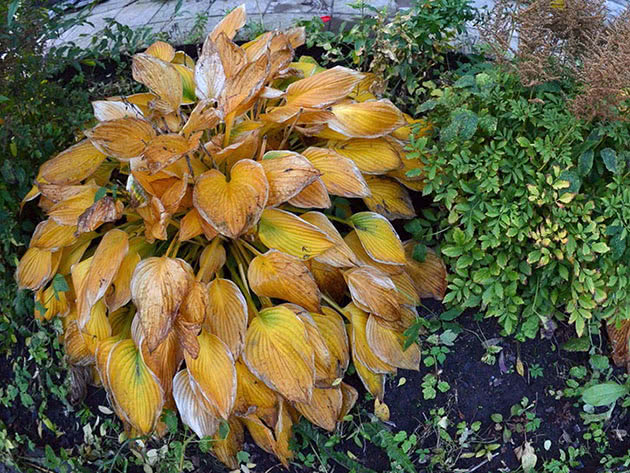
In autumn on the eve of winter it is necessary to insulate the site with hostas. In order to do this the site is mulched with leaf soil. Hostas growing under the trees especialle need this: thanks to the mulch, hosta will not lack the nutrients absorbed by the roots of the tree. Besides, mulch raises the level of the flower garden, and this improves drainage of the soil.
